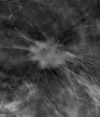Assessing radiologist performance using combined digital mammography and breast tomosynthesis compared with digital mammography alone: results of a multicenter, multireader trial
- PMID: 23169790
- PMCID: PMC5410947
- DOI: 10.1148/radiol.12120674
Assessing radiologist performance using combined digital mammography and breast tomosynthesis compared with digital mammography alone: results of a multicenter, multireader trial
Abstract
Purpose: To compare radiologists' diagnostic accuracy and recall rates for breast tomosynthesis combined with digital mammography versus digital mammography alone.
Materials and methods: Institutional review board approval was obtained at each accruing institution. Participating women gave written informed consent. Mediolateral oblique and craniocaudal digital mammographic and tomosynthesis images of both breasts were obtained from 1192 subjects. Two enriched reader studies were performed to compare digital mammography with tomosynthesis against digital mammography alone. Study 1 comprised 312 cases (48 cancer cases) with images read by 12 radiologists; study 2, 312 cases (51 cancer cases) with 15 radiologists. Study 1 readers recorded only that an abnormality requiring recall was present; study 2 readers had additional training and recorded both lesion type and location. Diagnostic accuracy was compared with receiver operating characteristic analysis. Recall rates of noncancer cases, sensitivity, specificity, and positive and negative predictive values determined by analyzing Breast Imaging Reporting and Data System scores were compared for the two methods.
Results: Diagnostic accuracy for combined tomosynthesis and digital mammography was superior to that of digital mammography alone. Average difference in area under the curve in study 1 was 7.2% (95% confidence interval [CI]: 3.7%, 10.8%; P < .001) and in study 2 was 6.8% (95% CI: 4.1%, 9.5%; P < .001). All 27 radiologists increased diagnostic accuracy with addition of tomosynthesis. Recall rates for noncancer cases for all readers significantly decreased with addition of tomosynthesis (range, 6%-67%; P < .001 for 25 readers, P < .03 for all readers). Increased sensitivity was largest for invasive cancers: 15% and 22% in studies 1 and 2 versus 3% for in situ cancers in both studies.
Conclusion: Addition of tomosynthesis to digital mammography offers the dual benefit of significantly increased diagnostic accuracy and significantly reduced recall rates for noncancer cases.
Supplemental material: http://radiology.rsna.org/lookup/suppl/doi:10.1148/radiol.12120674/-/DC1.
RSNA, 2012
Figures






References
-
- Shapiro S, Venet W, Strax P, Venet L, Roeser R. Ten- to fourteen-year effect of screening on breast cancer mortality. J Natl Cancer Inst 1982;69(2):349–355. - PubMed
-
- Tabár L, Fagerberg CJ, Gad A, et al. . Reduction in mortality from breast cancer after mass screening with mammography: randomised trial from the Breast Cancer Screening Working Group of the Swedish National Board of Health and Welfare. Lancet 1985;1(8433):829–832. - PubMed
-
- Tabár L, Vitak B, Chen HH, Yen MF, Duffy SW, Smith RA. Beyond randomized controlled trials: organized mammographic screening substantially reduces breast carcinoma mortality. Cancer 2001;91(9):1724–1731. - PubMed
-
- Tabár L, Vitak B, Chen HH, et al. . The Swedish Two-County Trial twenty years later: updated mortality results and new insights from long-term follow-up. Radiol Clin North Am 2000;38(4):625–651. - PubMed
-
- Tabár L, Vitak B, Chen TH, et al. . Swedish two-county trial: impact of mammographic screening on breast cancer mortality during 3 decades. Radiology 2011;260(3):658–663. - PubMed
Publication types
MeSH terms
LinkOut - more resources
Full Text Sources
Other Literature Sources
Medical

